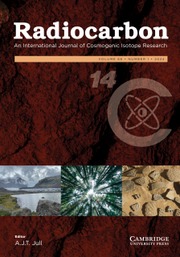No CrossRef data available.
Article contents
RADIOCARBON VARIATIONS IN ANNUAL TREE RINGS WITH 11-YEAR SOLAR CYCLES DURING 1800–1950
Published online by Cambridge University Press: 30 April 2024
Abstract
The results of radiocarbon variation studies observed in annual tree rings from the NW Pacific (USA Northwest) (Stuiver and Braziunas 1993) and Europe (England, Brehm et al. 2021; Slovakia, Povinec 1977, 1987) are reviewed with the aim of better understanding the 11-year radiocarbon cycle and possible impacts of solar proton events on 14C levels in the atmosphere and biosphere. The average Δ14C amplitude in tree rings for the period of 1798–1944 was 1.3 ± 0.3‰, the average periodicity was 11 ± 1 years, and the average time shift between the sunspot numbers and Δ14C records was 3 ± 1 years. A new solar activity minimum (Gleissberg minimum, 1878–1933) has been identified in the Δ14C data sets from the NW Pacific and England, showing Δ14C excess of 7‰, comparable to the Dalton minimum (1797–1823). No significant changes in Δ14C levels were identified that could be associated with solar proton events during 1800–1950.
- Type
- Conference Paper
- Information
- Radiocarbon , Volume 66 , Issue 5: 24th Radiocarbon and 10th 14C & Archaeology, Zurich, Sept. 11–16, 2022 Proceedings Part 1 of 2 , October 2024 , pp. 973 - 988
- Copyright
- © The Author(s), 2024. Published by Cambridge University Press on behalf of University of Arizona
Footnotes
Selected Papers from the 24th Radiocarbon and 10th Radiocarbon & Archaeology International Conferences, Zurich, Switzerland, 11–16 Sept. 2022



